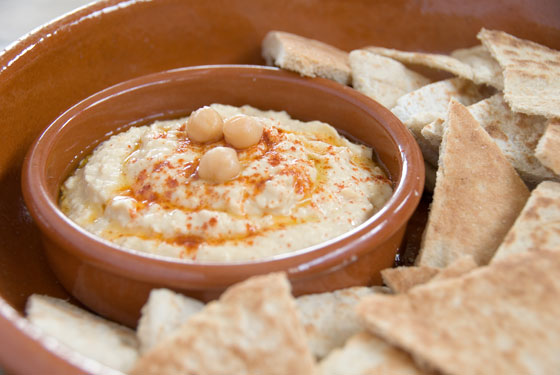
Years ago, long before our supermarket chillers were packed with processed dips and at a time when my favourite cookbooks were Moosewood and The Enchanted Broccoli Forest, I started a love affair with hummus. Wellington based at the time, we had a wonderful Turkish restaurant in Cuba St (Cafe Istanbul?) who along with other tasty delights, made the best hummus imaginable. A thick luscious textured hummus that was loaded with enough garlic to ward off vampires for the week, we almost licked the bowl clean.
This was a time when chickpeas or garbanzo beans as they are also known, were sold dried, I don’t think there were cans available and if so then we had never seen them.
Grown throughout the Middle East chickpeas are delicious when fresh but most commonly found as dried beans.
Hummus from dried chickpeas is started the day before with soaking the chickpeas in plenty of cold water (with some bicarbonate soda to aid softening), the next day the water is poured off, the chickpeas rinsed and then covered with plenty of cold water and boiled until tender. Once cooked they are drained and sometimes peeled (a purist will tell you that removing skins makes better textured hummus), the chickpeas are then blended with garlic, lemon juice, salt and enough tahini to give richness and flavour but not so much as to dominate the chickpeas. I also add cumin as I think it is essential for flavour.
Then there was the time when dried legumes in NZ were impossible. If you could find them you couldn’t get them to cook, no matter how hard you tried. Something to do with the treatment of the beans before being allowed into NZ I think?
Once the dried legumes stopped being available everywhere there seemed to be a huge shift to canned chickpeas and with that change hummus could be made in an instance. Cheap and readily available, you only need to drain and rinse the chickpeas before proceeding with making hummus. But are you compromising on taste?
While you are unlikely to get the same creamy richness that comes from dried chickpeas you can still make a hummus from canned chickpeas decidedly better than the bland gloop in the supermarket chillers, and the convenience factor of having canned chickpeas in the pantry is hard to beat.
One of the things I have love most about hummus is the ability to throw it together in a flash and there you have it – hummus, no cooking no chilling but hummus ready to eat.
Homemade and cheap but perhaps a little on the cheating side as I do tend to use canned chickpeas as while I aspire to soaking overnight and then cooking the dried, I am just not a forward thinker. If I decide I want hummus I make it – done!
In this world of convenience shopping there is hummus of every flavour imaginable in the supermarket chiller and while many are OK, nothing quite compares to a good homemade hummus.
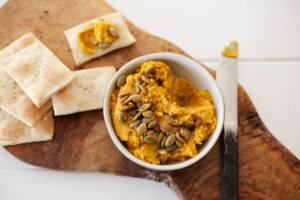 From its humble beginnings in the Middle East, like most recipes hummus has been chopped and changed at food writers whims. Those who shun the fat content of tahini will often use yoghurt instead, sweet chilli sauce appears in some recipes as does parsley, sundried tomatoes and a whole range of flavours.
From its humble beginnings in the Middle East, like most recipes hummus has been chopped and changed at food writers whims. Those who shun the fat content of tahini will often use yoghurt instead, sweet chilli sauce appears in some recipes as does parsley, sundried tomatoes and a whole range of flavours.
While I prefer to stick close to the original I do often make pumpkin hummus, enjoying the velvet smooth texture and the toasted seeds on top.
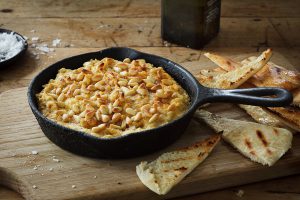 Another variation that is close to the original is heating hummus in a hot oven and serving it warm with pita bread. Lovely for a mid winter dip.
Another variation that is close to the original is heating hummus in a hot oven and serving it warm with pita bread. Lovely for a mid winter dip.
However you make your hummus, take the time to think about the balance of flavours, the quantity of garlic, salt and lemon juice that you prefer and the ratio of tahini to chickpeas.
2 cups dried chickpeas
1/3 cup tahini
1/2 teaspoon cumin
juice of 1 lemon
3 cloves garlic, finely chopped
extra virgin olive oil
paprika
Soak chickpeas over night (8 hours) in plenty of cold water and 1 teaspoon bicarbonate soda. Drain and rinse chickpeas and then cook in a large saucepan with plenty of water for approximately 45 minutes until tender. Remove from the heat, drain and cool. Set aside a few chickpeas to garnish hummus with if you like.
Place chick peas in a food processor along with tahini, cumin, lemon juice, garlic and a generous sprinkle of salt. Process until a thick paste adding a little water until you reach the consistency needed. Taste and adjust flavours if needed .
Serve with a drizzle of olive oil and a sprinkle of paprika.
Excess hummus can be stored for up to a week in a covered container in the refrigerator.
Tahini is available in most supermarkets and lasts well in the fridge once opened.
Has anyone else tried fresh chickpeas? On a trip to San Francisco earlier this year we found fresh chickpeas used in salads and as garnish at a quite a few restaurants.
They are reported to be growing here in Taupo but I haven’t seen them…

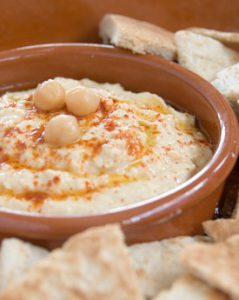
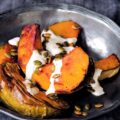



Try a little honey in the mix it really bring s the flavours out
Hi Helen, I don’t particularly like the flavour of raw sesame seeds, so to avoid tahini, I gently toast sesame seeds ( in a wee saucepan over low heat) then blitz them to a paste and use that instead. I also think it may be a bit more economical, as sesame seeds ( purchased in bulk) are cheaper than tahini.
Thank you for this recipe :)
I don’t even understand how I stopped up here,
but I believed this post was once good. I don’t know who you might be however
certainly you are going to a famous blogger
if you are not already. Cheers!
Sorry I was not clear.Under the chapter of Clos St Marc (Monopoly I expect a description of Clos St. Marc, but you refer to a none excisting Les Corvees (which is not above…). I can get some Clos St Marc 2009, that’s why I’m interested.
You’ve got it in one. Couldn’t have put it better.
I can say for sure this will be one of the most charished memories of your mother. The Biggest Blessing is that she is still with you to enjoy the gifting with you! I rejoice with you and thank you so much for shareing your deep love and gratitude beyond the struggles that is the most wonderful pearl of great price.Blessing on you and yours this Wonderful Thanksgiving.
It’s really great that people are sharing this information.
Love the ideas above. I buy a big bag of dried chickpeas (and kidney beans), cook them and then freeze flat in resealable bags in “can size” lots, including a little liquid. I also freeze cubed roasted pumpkin and kumara in similar quantities, and can have hummus made almost as quickly as using cans with the fresh flavour.
I freeze lots of different beans and brown rice this way – think freezing flat makes the storage easier and faster thawing. I’m not organised enough to think of presoaking for a recipe, so this method helps me.
I, too, tend to use the cooking liquid and extra lemon juice instead of adding oil if I can to reduce calories.
I subscribed quite a long time ago to become a member but have not received any newsletters as yet.
I usually cook my chickpeas from dry (using a pressure cooker saves time) and have found that the slow cooker is fantastic for being able to just put them on to cook and walk away. Having said that I have a few cans on hand for instant meals or hummus. I made my own Tahini, so simple, so made extra cheap hummus. I don’t put in the oil, to keep calories down and just use a little of the cooking water if required for consistency.
I have a great roast pumpkin and chickpea salad recipe which is delish! Of course so many good vege curries with chickpeas too.
Bernice. This doesn’t get rid of the toxins that you need to get rid of with a slow soak,
If you really want some fun, make some refried beans with pressure cooked beans.
Sure they are soft in the mouth, but not soft on the seat.
Mmmmm. I used to make refried beans 15 or so years ago, and have just “got back into them” when searching for some ideas when a vegetarian friend visited. They are soooooo yum – and I think most meat eaters wouldn’t notice there was no meat. Have just cooked up lots of kidney beans ready for some more. The last time I served them in “baskets” made of baked wraps. It looked fab and was super easy.
It is much cheaper to cook your own chickpeas in the slow cooker and they taste much better than the canned ones.
I love hummus too, always make it from canned chickpeas and it MUST have cumin, but my question is -why not make your own tahini too? I have tried blending toasted sesame seeds with a little sesame oil, which isn’t bad, but is there a better recipe please?
I recently had my first ‘authentic’ hummus in Dubai, which was absolutely smooth and quite a different experience from NZ supermarket standard!
I’ve since discovered that pureeing the chickpeas HOT (even still with the skins) can help achieve this delicious texture. Planning on making my own to test this ASAP.
Yes, there are rows and rows of expensive dips in the Supermarkets. Salty paste is all it is though. Homemade hummus yum!
Dried chickpeas are the way to go. One of the comments was about the heat treated imported chickpeas. About 5-6 years ago MAF upped the requirements for dried imported legumes etc…MAF required that they be heat treated for import. This indeed does adversely affect the cooking and soaking process. Most retailers who sell loose food sell heat treated beans/chcikpeass etc…However there are some that get their beans certified at the country of the origin to be free of insects and eggs – before packing for export. I guess I can’t plus any in particular but my local bean man doesn’t have his beans treated with heat.
This heat treatment added cost to the beans, they doubled in price. From my experience this coincided with the proliferation of canned beans in the supermarket cos they were now comkpetitive price wise.
MAF Certification at origin also added to the price, and is a bit trickier from a importers perspective. So not all dried chickpeas are equal. But most are suitable for Hommusexuals.
I have a tribe to feed and make a big batch of hummus on a regular basis, we only use home soaked/boiled chickpeas, we find they make a far nicer hummus. Omur kids aged from preschooler through to young adults love it. Adding 3-4 sundried tomatoes to some of the hummus is also very popular, just make sure you process these well first to avoid strong tasting clumps. Our kids love to eat hummus with raw veges especially carrots and cucumber. We are also trying out raw broccoli and cauliflower and we don’t just use hummus as a snack but as a whole lunch with veges/crackers, usually when the weather is a bit warmer though as we are in the South. We also enjoy hummus with homemade burgers. Freezing extra peas/beans is a great idea/shortcut.
I regularly buy dried chickpeas and instead of boiling them I cook them in the slow cooker as per Aliston Holst’s recipe and then use them for all sorts of things including hummus.
I make my own hummus, I’ve never soaked the chick peas nor used baking soda though. Just boiled, in pressure cooker or lately, popped into crock pot, well covered with water and leave on high, they cook in about 4 hours, excellent! and I freeze excess so they’re ready when I want them. My hummus lasts for ages int he fridge and Tahini lasts years! The shop bought ones are so high in fat and you can make them pretty much low fat at home, only the Tahini and olive oil (if you want it, which I don’t), mmm, might get some chick peas out of freezer. Great high protein snack.
I’ve never used baking soda either, for any of my recipes with dried beans, peas, etc. It destroys the vitamins etc, and does nothing for the chickpeas. They cook nicely without it.
I usually just use a little sesame oil instead of Tahini. I like to add chopped fresh coriander sometimes for a change. Homemade beats bought stuff every time!!
You’re right about the imported beans being treated. They were (and I think often still are) heat-treated. This makes them pretty much impossible to rehydrate properly. Buy local if you can, or grow them. I can grow good drying beans here in Christchurch, though not chickpeas.
I forgot to say that a pressure cooker will cook chickpeas in no time!
I’ve still got my Moosewood and Enchanted Broccoli Forest cookbooks – can’t remember when I last used them but I like the security of them on my shelf.
Me too Renee, I do sometimes glance their way but then remember how many days in advance each recipe seemed to take…
I cook a whole bag of chickpeas at once in my crockpot then freeze them so that they’re ready for any recipe needing them. Saves time. They can be thawed quite quickly, especially if you pour some hot water on them and leave them to stand for about 15-20 minutes while you prepare everything else. Beats using tinned chick peas regarding price.
Yes Lorna I have done the same. I never peel the chickpeas but I have heard it makes a superior hummus. Will try the cumin.